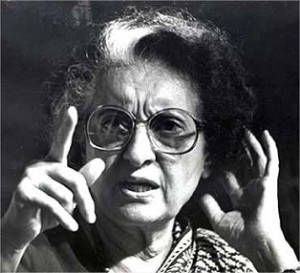The Ford Foundation’s Quest to Fix the World – this New Yorker piece in the January 2016 issue of the magazine by someone named Larissa MacFarquhar caught my eye.
The first: “In April, the government froze the bank accounts of Greenpeace India, and in the same month cancelled the registration of nearly nine thousand N.G.O.s that received money from abroad.”
-
In October 2014, the government of India had sent notices to 10,343 NGOs that received foreign funds for not filing their annual returns for three years in a row – 2009-10, 2010-11 and 2011-12. Only 229 replied.
-
Therefore, in April 2015, the licenses of approximately 9000 NGOs were cancelled. Not as a retributive measure – as the article implies – but for not following the law of the land, after following due process. [source: India Today report, April 28, 2015, link]
Hence my conclusion that the writer of the piece failed – either due to incompetence or worse – to follow basic journalistic ethics.
The second item that caught my attention was more serious.
In an attempt to appear objective, the writer tried to include some criticisms of the Ford Foundation’s activities in India. This is what the pertinent sentence is: “responding to government concerns about overpopulation, Ford funded research that led indirectly to a forced-sterilization program in the mid-seventies that unintentionally killed close to two thousand people owing to botched surgeries.”
Now, this line is something that goes beyond mere journalistic incompetence and enters the hallowed grounds of PR whitewashing on behalf of Ford Foundation. Whitewashing of Ford Foundation’s culpability in the mass-murder of millions of fetuses. Of female fetuses, to be precise by making it sound that Ford Foundation was at best guilty of funding the incompetent, nothing more. The truth, however, is far more serious, and paints the Ford Foundation in a much, much darker light.
That is a rather fantastical accusation to make, isn’t it? If yes, it’s only because it’s true.
In the 1960s – over half a century ago, when paranoia over communism was at its peak in the West, it was argued that poverty helped fuel a drive towards communism. The thinking in the West went that over-population was a big contributing factor towards poverty.
 Therefore poor nations with large populations (India, China) were most at risk of being overrun by communism. These nations had to be stopped from over-breeding. Ergo, the UN, World Bank, Ford Foundation, and other eminent groups teamed up together to come up with strategies.
Therefore poor nations with large populations (India, China) were most at risk of being overrun by communism. These nations had to be stopped from over-breeding. Ergo, the UN, World Bank, Ford Foundation, and other eminent groups teamed up together to come up with strategies.US President Lyndon Johnson in 1965 had remarked: “Less than $5 invested in population control is worth a hundred dollars invested in economic growth.” “In 1965, Alaskan Senator Ernest Gruening, aware of the forecasts for trouble in India and cheered by Johnson’s willingness to address the issue, launched a three-year series of hearings on the population crisis.”
Eminent personalities who worried about the “population bomb” included John D. Rockefeller III, who decided to do something about it. A gathering took place in 1952: the “Conference on Population Problems“, to discuss the possibility of exporting population control to “poor growing countries”, and India was at the top of everyone’s mind there.
By the late 1970s the western advisors had mostly left, and it was only recently that the IPFF and Rockefeller archives were opened up. The “story begins in the mid 1960s” when Sheldon Segal headed to India. Segal had been hired by John D Rockefeller II and he became head of the Population Council’s biomedical division. In India, he became personal advisor to the head of India’s director of family planning operations.
This done, “Segal’s primary assignment while in Delhi was to found the department of reproductive physiology at the AIIMS.”
“Western money had backed the creation of an extensive network of community family planning advisers in India.“
During these years, the Rockefeller Foundation had its largest staff outside New York in Delhi. Personnel from the Ford Foundation “alone numbered in the hundreds”. This prompted a “senior government official” to state “watching with anxiety the increasing penetration and power of foundations like the Ford [and] Rockefeller … in governmental spheres.”
Money without strings was not acceptable. India at the time got $1.5 billion in annual aid, much of it from the U.S. government, UNFPA, the Ford Foundation, and the World Bank. The Rockefeller Foundation representative thought India was “in danger of becoming ‘nigger rich.'” [emphasis mine] Therefore, “the Rockefeller Foundation first posted an employee at AIIMS in 1958 as an adviser to the institute’s director.”
 Mrs. Indira Gandhi was awarded the United Nations Population Award – the first recipient of this award, in 1983.
Mrs. Indira Gandhi was awarded the United Nations Population Award – the first recipient of this award, in 1983.“In 1975 AIIMS, the country’s most prestigious medical school, unveiled India’s first amniocentesis tests at its govt teaching hospital.” Other hospitals quickly started offering the test. Doctors not only readily identfied the sex of the foetus, but also offered to abort if it was a female foetus. Several AIIMS doctors published papers “explaining the project as an experimental trial with potential to be introduced on a larger scale.”
Therefore, these foundations and their money comes with at a heavy, heavy cost. It may well be a perfect example of a Faustian bargain.
But there is an even deeper story here. One whose facts run contrary to the charge of misogyny and patriarchy hurled at Indians, and especially Hindus, in arguing that a bias against the female child has been an invariant of Hindu India for millennia.
Here again, facts speak otherwise, and paint yet another grim picture of yet another genocide that western intervention wreaked. This time, you have to go back a hundred or more years.
When the British conducted the first census in the Indian colony (in the last quarter of the nineteenth century), they found a skewed gender ratio, even then.They looked to Hindu texts to explain this bias against the girl child but actually found that Hindu texts condemned the killing of foetuses, without exception. So much so that even John William Kaye, the East India Company historian, had to concede in his “curmudgeonly way”: “It is almost the one exceptional case of a barbarous custom that has not the sanction expressed or implied, by precept or example, of the monstrous faith [Hinduism] which these people profess.”
So what was behind the practice of female infanticide? After all, if it had been a “custom”, no group could have survived for millennia practicing this “custom.”
A clue lay in the fact that the practice was more widespread among land owning groups. Lower castes had simply “copied” the practice. “As time went on, the idea that some castes and tribes had always killed girls evolved into doctrine.”
When the British took control over the country, they centralized land administration and introduced stricter property rights than what the Mughals had enforced. European “medieval feudalism” was transported to India.”Women had once held property rights,but now they were excluded from owning land.”
The three chief takeaways from this are:
Chief reference: “Unnatural Selection: Choosing Boys Over Girls, and the Consequences of a World Full of Men”, by Mara Hvistendahl [link]
Disclaimer: views expressed are personal.
Abhinav Agarwal is a son, husband, father, technologist and an IIM-B Gold Medalist.

